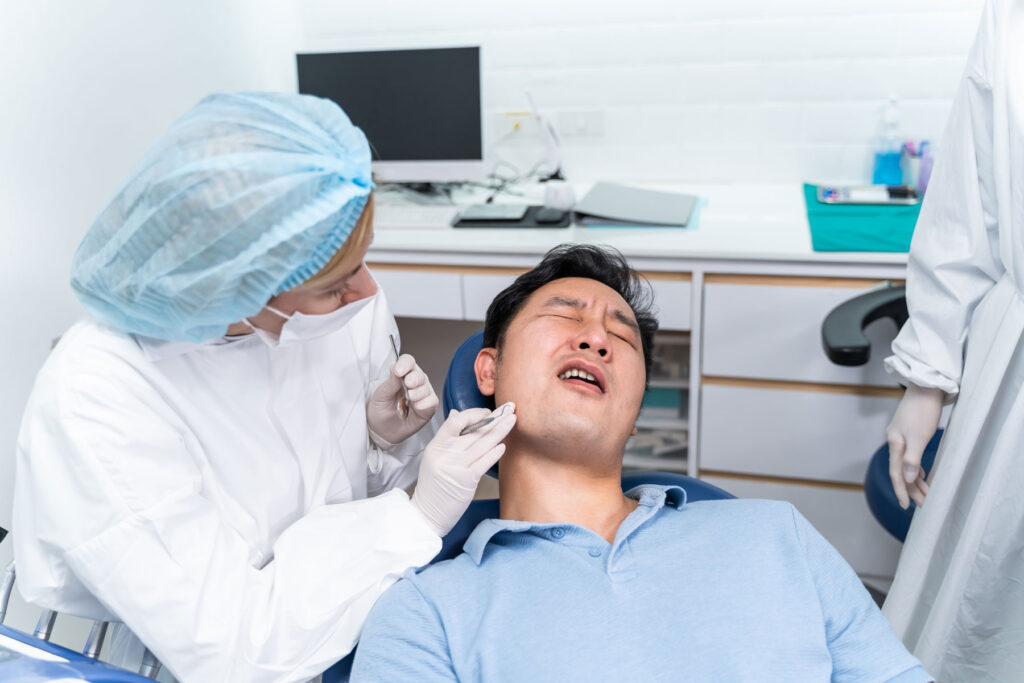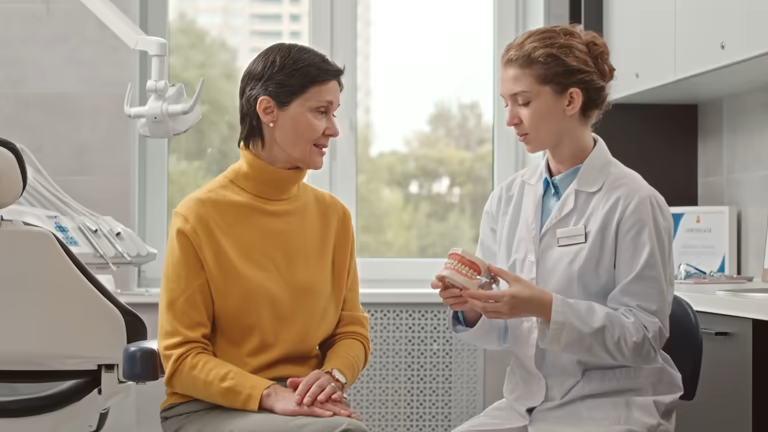Right after a tooth extraction, your dentist will give you clear instructions on what to eat. The reason for the soft food diet is incredibly important and is directly related to how your body heals. When a tooth is removed, a blood clot forms in the empty socket. This clot is a crucial part of the healing process because it protects the underlying bone and nerves. It’s a natural bandage, and its job is to allow new tissue to form and the area to heal properly. The main reason dentists recommend soft foods is to protect this delicate clot. Eating hard, crunchy, or chewy foods can easily dislodge the clot, which leads to a very painful condition called a dry socket. A dry socket is a very uncomfortable situation where the bone and nerves are exposed, and it can significantly delay your recovery. It’s a key reason why the first 24-48 hours are so critical. The patient’s adherence to the soft food diet is essential for a smooth recovery and will significantly influence the timeline for eating after extraction. We at Smiles for Health DDS take great care to ensure our patients have a smooth and comfortable recovery, and we provide detailed instructions on what to eat and what to avoid. You can also visit our page on dental extractions for more information about the procedure and our commitment to your care.
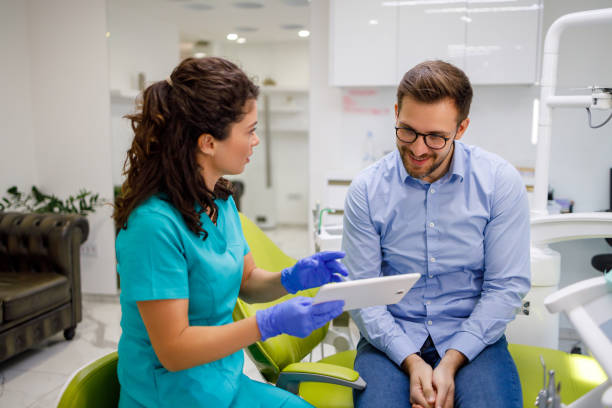
Beyond protecting the blood clot, a soft food diet also helps to prevent irritation and bleeding at the extraction site. Chewing on hard foods can put a lot of pressure on the healing area, which can cause bleeding to start again or increase the risk of infection. Soft foods, on the other hand, require very little chewing and can be swallowed easily. This allows the surgical site to rest and heal without being disturbed. A well-balanced diet is also important for a quick recovery, and soft foods can still provide you with the necessary nutrients. You should focus on foods like yogurt, smoothies, soups, scrambled eggs, and mashed potatoes. These are all easy to eat and can help your body heal faster. We believe in a holistic approach to your dental health, and we will always provide you with a comprehensive plan for your recovery. We are also available for emergency dental needs, and you can learn more about our options for emergency dental care if you have a problem that needs immediate attention.
What Should You Eat After Tooth Extraction?
- Soups and broths: These are easy to eat and can provide a lot of nutrients.
- Yogurt and smoothies: These are great for a quick and easy meal and can be very soothing.
- Mashed potatoes: A classic comfort food that is soft and easy to eat.
- Scrambled eggs: A good source of protein that is easy to chew.
- Soft fruits: Bananas and avocados are great choices and are full of vitamins.
The most important thing to remember is that the initial soft food diet is a temporary measure. It’s a small sacrifice for a smooth and fast recovery. The question of when can i eat solid food after tooth extraction is a very common one, and the answer is that you have to be patient and follow your dentist’s instructions. We at Smiles for Health DDS are here to help you every step of the way, from the extraction to the recovery. We are committed to your comfort and well-being. You can also learn more about our options for general dentistry offers and how we help you get the smile you want.
When you are ready to find out when to eat normally after tooth removal, we are here to guide you. Contact us today for a consultation so we can help you with your dental needs and get you back to feeling your best.
When Is It Safe To Start Eating Solid Foods Again?
The timeline for eating after extraction is one of the most pressing questions for many patients. The desire to get back to a normal diet is completely understandable, but it’s crucial to approach it with caution. The general rule is to wait at least 24 hours before you even consider anything other than liquids and very soft foods. The first 2-3 days are the most critical for clot formation and initial healing. During this time, you should stick to a very soft diet and avoid chewing near the extraction site. After the first 72 hours, you can gradually start to introduce some slightly more solid, but still soft, foods. This could include things like pasta, rice, or soft cooked vegetables. The key is to chew very carefully and use the other side of your mouth as much as possible. This is a crucial step in the timeline for eating after extraction. The process is a gradual one, not a sudden switch. We at Smiles for Health DDS will provide you with a detailed plan for your recovery, including when you can expect to introduce new foods back into your diet. We also have a variety of other services that can help you with your dental needs, including dental fillings to fix a cavity.
It can take up to a week for the initial healing to happen and for the empty socket to start to close. Even after a week, the area will still be tender, and you should be careful with what you eat. You should continue to avoid hard, crunchy, and sticky foods for at least a couple of weeks, or until your dentist gives you the green light. The answer to when can i eat solid food after tooth extraction is not a specific date, but a gradual process based on how you feel. Everyone heals at a different rate, so listening to your body is essential. If you feel pain or discomfort when you try to eat something, you should stop immediately and go back to a softer diet. The goal is to avoid causing any new bleeding or dislodging the blood clot. It is always better to be cautious than to risk a dry socket or an infection. We believe in providing our patients with the best possible care, and that includes a smooth recovery. You can also learn about our other services, including dental bridges to replace a missing tooth.
What Is A Typical Timeline For Eating After An Extraction?
- First 24 hours: Stick to a liquid and very soft food diet.
- 2-3 days: You can start to introduce slightly thicker foods, like yogurt and scrambled eggs.
- 4-7 days: You can try some soft cooked vegetables, pasta, and rice.
- 1-2 weeks: You can gradually start to introduce more solid foods, but be careful.
- After 2 weeks: You can usually start to eat normally, but you should still avoid very hard or crunchy foods.
The most important thing to remember is that your dentist is your best resource for information about your recovery. We will always give you a personalized plan that is tailored to your specific needs. The question of when to eat normally after tooth removal is one that you should ask at your follow-up appointment. We can also help with a variety of other dental needs, and you can learn more about our options for dental crowns to protect your teeth.
If you have questions about when can i eat solid food after tooth extraction, we are here to help. Contact us today for a consultation so we can help you with your dental needs and get you back to feeling your best.
What Signs Show You’re Ready For Solid Food After Extraction?
Knowing when can i eat solid food after tooth extraction is a matter of listening to your body and looking for specific signs of healing. While a set timeline is a good general guide, your body will tell you when it’s ready to move on. The most important sign is that the pain is gone or very minimal. If you no longer need pain medication to feel comfortable, that’s a good indication that the initial healing has taken place. You should also check for any bleeding at the extraction site. If there is still any bleeding, you should not be eating solid foods. The site should also be free of any swelling or puffiness. As the swelling goes down and the pain subsides, you can start to consider introducing some soft, solid foods. The timeline for eating after extraction is a gradual process, and these signs are your guide. We at Smiles for Health DDS will provide you with all the information you need to make sure you have a smooth and comfortable recovery. You can also learn about our other services, including exams and cleanings to keep your smile healthy and beautiful.
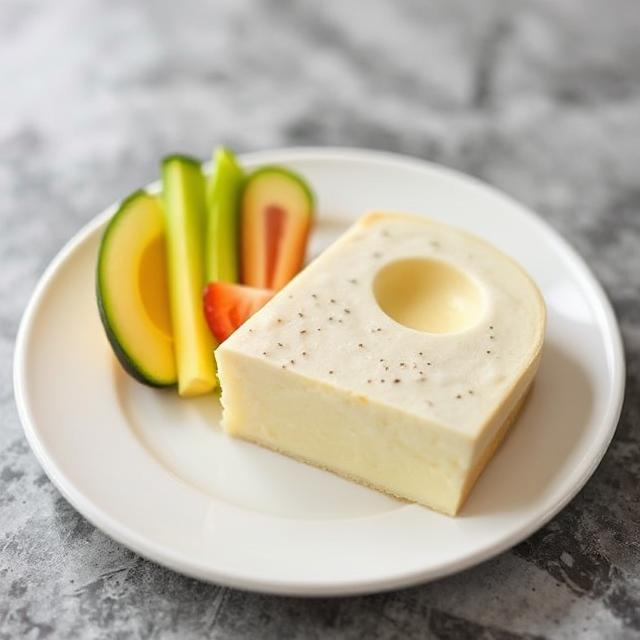
Another important sign is that you can open your mouth without any discomfort or tightness. If you feel any stiffness or pain when you try to open your mouth, you should stick to a softer diet. You can also visually check the extraction site. The site should be covered by a healing clot, and it should not look red or inflamed. The goal is to avoid dislodging the clot and to prevent a dry socket. When you are ready to try solid foods, you should start with a very small bite and chew very carefully on the opposite side of your mouth. If you feel any pain or discomfort, you should stop immediately and go back to a softer diet. The key is to not rush the process. The question of when to eat normally after tooth removal is one that you should ask at your follow-up appointment. We believe that your health and safety are our top priority. We can also help with a variety of other dental needs, and you can learn more about our options for smile makeovers to help you get the smile you’ve always wanted.
What Signs Indicate A Safe Return To Solid Food?
- Pain is minimal or gone: You should not feel any sharp or throbbing pain at the extraction site.
- No more bleeding: The extraction site should not be bleeding at all.
- Swelling is gone: The swelling and puffiness around the extraction site should be gone.
- You can open your mouth without discomfort: You should be able to open your mouth without feeling any stiffness or pain.
- The site looks healthy: The extraction site should look like it is healing well and should not be red or inflamed.
A dental extraction is a serious procedure, and the recovery process is very important. While you might be tempted to jump back into your normal routine, you should be patient and follow your dentist’s instructions. The question of when to eat normally after tooth removal is one that you should ask at your follow-up appointment. We at Smiles for Health DDS are committed to providing you with the best possible care, and we can help you with a solution that will protect your tooth and get you back to feeling your best. We are experts at restoring smiles, and we can help with a variety of issues, including dental implants if you have a missing tooth that needs a replacement. Contact us today for a consultation so we can help you with your dental needs and get you back to feeling your best.
What Are The Best Foods To Transition Back To Normal Eating?
The journey back to your regular diet after a tooth extraction is a gradual one, and it’s important to make smart food choices. Knowing when can i eat solid food after tooth extraction is not about picking a date on the calendar, but about listening to your body and transitioning slowly. When you are ready to move past a liquid and soft food diet, you should start with foods that are easy to chew and won’t put any pressure on the healing area. This is a very important part of the timeline for eating after extraction. You should avoid anything that is hard, crunchy, or sticky. Foods that require a lot of chewing can irritate the extraction site and can even cause the blood clot to become dislodged. We at Smiles for Health DDS will provide you with a detailed recovery plan, including recommendations on what foods to eat and when. We want to make sure your recovery is as smooth and comfortable as possible. We can also help you with a variety of other dental needs, and you can learn about our options for dental bridges if you have a missing tooth that needs a replacement.
A good rule of thumb is to focus on nutrient-rich foods that can aid in the healing process. Foods like soft-cooked vegetables, well-mashed potatoes, and tender pasta or rice are excellent choices. You can also include sources of protein like soft-cooked fish or ground meats. The key is to make sure the food is very easy to eat and doesn’t require any forceful chewing. You should also continue to chew on the opposite side of your mouth to avoid any pressure on the healing site. The goal is to return to your normal diet without causing any complications. We believe in providing our patients with the best possible care, and that includes a smooth recovery. The question of when to eat normally after tooth removal is one that you should ask at your follow-up appointment. We can also help with a variety of other dental needs, and you can learn more about our options for preventive dentistry to keep your smile healthy and beautiful.
What Foods Are Safe For The Transition?
- Soups and stews: These are a great way to get a lot of nutrients and are very easy to eat.
- Soft vegetables: Carrots, broccoli, and cauliflower that are cooked until they are very tender are great options.
- Tender proteins: Soft fish or chicken that is cooked until it is very tender can be a good source of protein.
- Pasta and rice: These are easy to chew and can be a good source of carbohydrates.
- Mashed foods: Mashed potatoes and bananas are easy to eat and can provide a lot of energy.
A tooth extraction is a significant procedure, and a successful recovery depends on careful management of your diet. While you might be tempted to jump back into your normal routine, a gradual approach is the best way to ensure a smooth and comfortable healing process. We at Smiles for Health DDS can also help with a variety of other dental needs, and you can learn more about our options for dental crowns to protect your teeth.
If you have questions about when you can eat solid food after tooth extraction, we are here to help. Schedule a consultation to discuss your recovery and next steps.
How Can Eating Too Early Affect Your Healing?
Resuming your normal eating habits too soon after a tooth extraction can have some very serious consequences. The most common and painful complication is a dry socket. This happens when the blood clot that forms in the empty socket is dislodged, leaving the underlying bone and nerves exposed. This can cause a lot of pain and can significantly delay your recovery. The timeline for eating after extraction is in place for a reason, and not following it can lead to a lot of unnecessary pain and discomfort. When you eat hard, crunchy, or chewy foods, you can put a lot of pressure on the healing area and cause the blood clot to break away. This is why it is so important to stick to a soft diet for the first few days. We at Smiles for Health DDS will provide you with all the information you need to make sure you have a smooth and comfortable recovery. You can also learn about our other services, including root canals to save your natural tooth.
Beyond a dry socket, eating too early can also cause an infection. The extraction site is a wound, and it is very vulnerable to bacteria from your mouth. When you eat, you can introduce food particles into the wound, which can lead to an infection. An infection can cause a lot of pain, swelling, and can even cause a fever. The question of when can i eat solid food after tooth extraction is a very common one, but the honest answer is that you have to be patient. It is always better to be cautious and to stick to a soft diet for a few extra days than to risk a serious complication. The timeline for eating after extraction is in place to protect your health and to ensure a smooth recovery. We believe that your health and safety are our top priority. We can also help with a variety of other dental needs, and you can learn more about our options for dental implants to replace a missing tooth.
What Are The Risks Of Eating Too Early?
- Dry socket: The blood clot can be dislodged, leading to a very painful condition called a dry socket.
- Infection: Food particles can get into the wound and cause an infection.
- Increased bleeding: Chewing on hard foods can cause the extraction site to start bleeding again.
- Delayed healing: Eating too early can slow down the healing process and prolong your recovery time.
- Damage to the gums: The pressure from chewing on hard foods can cause damage to the gums around the extraction site.
The answer to when to eat normally after tooth removal is not a specific date, but a gradual process based on how you feel. It is important to listen to your body and to follow your dentist’s instructions. We at Smiles for Health DDS are committed to providing you with the best possible care, and we can help you with a solution that will protect your tooth and get you back to feeling your best. We are experts at restoring smiles, and we can help with a variety of issues, including smile makeovers to help you get the smile you’ve always wanted.
For personalized advice on how to care for your smile after a dental extraction, reach out to our friendly team at Smiles for Health DDS.
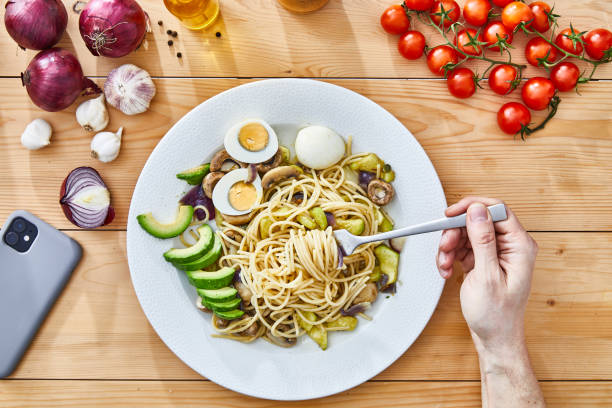
What Timeline Do Dentists Recommend For Recovery?
The timeline for eating after extraction is a very important part of your recovery, and your dentist will give you a detailed plan that is tailored to your specific needs. The general timeline is a good guide, but it is important to remember that everyone heals at a different rate. The first 24 hours are the most critical, and you should stick to a liquid and very soft food diet. During this time, you should avoid using a straw, as the suction can dislodge the blood clot. You should also avoid hot drinks and alcohol. The question of when can i eat solid food after tooth extraction is a common one, but the honest answer is that you have to be patient. The first few days are all about protecting the blood clot and allowing the initial healing to happen. We at Smiles for Health DDS will provide you with all the information you need to make sure you have a smooth and comfortable recovery. You can also learn about our other services, including dental fillings to fix a cavity.
After the first 24-48 hours, you can start to introduce some slightly more solid, but still soft, foods. You should continue to chew on the opposite side of your mouth to avoid any pressure on the extraction site. By the end of the first week, you can usually start to eat a slightly more solid diet, but you should still be very careful. You should avoid any foods that are hard, crunchy, or sticky. The answer to when to eat normally after tooth removal is a gradual process, and it is important to not rush it. It can take up to two weeks for the area to heal enough for you to return to your normal diet. Even after two weeks, you should still be careful with very hard or crunchy foods. The timeline for eating after extraction is in place to protect your health and to ensure a smooth recovery. We believe that your health and safety are our top priority. We can also help with a variety of other dental needs, and you can learn more about our options for dental sealants to protect your teeth from decay.
What Is The Recommended Recovery Timeline?
- Day 1: Stick to a liquid and very soft food diet.
- Days 2-3: You can start to introduce some slightly more solid, but still soft, foods.
- Day 4-7: You can try some soft cooked vegetables, pasta, and rice.
- Week 2: You can gradually start to introduce more solid foods, but be careful.
- After 2 weeks: You can usually start to eat normally, but you should still avoid very hard or crunchy foods.
The most important thing to remember is that your dentist is your best resource for information about your recovery. We will always give you a personalized plan that is tailored to your specific needs. The question of when to eat normally after tooth removal is one that you should ask at your follow-up appointment. We at Smiles for Health DDS are committed to providing you with the best possible care, and we can help you with a solution that will protect your tooth and get you back to feeling your best. We are experts at restoring smiles, and we can help with a variety of issues, including oral cancer screenings to keep you healthy.
To ensure your recovery goes as smoothly as possible, book an appointment with us to review your post-operative care instructions.
Frequently Asked Questions
When can I eat solid food after tooth extraction if my pain is gone?
Even if pain is gone, the healing site is still fragile. Smiles for Health DDS explains that when can I eat solid food after tooth extraction usually depends on clot stability. The timeline for eating after extraction is typically 3–7 days, and when to eat normally after tooth removal is confirmed by your dentist.
Does the timeline for eating after extraction change for wisdom teeth?
Yes, wisdom teeth often require more healing time. Smiles for Health DDS notes that when can I eat solid food after tooth extraction may extend to 7 days or more for wisdom teeth. When to eat normally after tooth removal varies by complexity.
Can I eat soft bread before the timeline for eating after extraction ends?
Soft bread may still pull on the clot. Smiles for Health DDS advises that when can I eat solid food after tooth extraction is safest after the site closes. When to eat normally after tooth removal depends on individual healing.
Why is the timeline for eating after extraction important for recovery?
Eating too soon can dislodge the clot and cause dry socket. Smiles for Health DDS emphasizes that when can I eat solid food after tooth extraction matters for proper healing. Knowing when to eat normally after tooth removal prevents complications.
When can I eat solid food after tooth extraction if stitches were placed?
Stitches help but don’t mean instant healing. Smiles for Health DDS explains that the timeline for eating after extraction is still a few days. When to eat normally after tooth removal should follow your dentist’s post-op advice.
Does the timeline for eating after extraction change if multiple teeth were removed?
Yes, more extractions require longer healing. Smiles for Health DDS notes that when can I eat solid food after tooth extraction is longer when several teeth are involved. When to eat normally after tooth removal depends on case complexity.
Can I eat solid food earlier if I chew on the opposite side?
It may help, but risk remains. Smiles for Health DDS advises that when can I eat solid food after tooth extraction still depends on healing. The timeline for eating after extraction ensures safety even with opposite-side chewing.
What happens if I eat solid food too soon after extraction?
It may reopen the wound and delay healing. Smiles for Health DDS explains that when can I eat solid food after tooth extraction is key to avoiding dry socket. Following the timeline for eating after extraction ensures smoother recovery and tells you when to eat normally after tooth removal.
Does age affect the timeline for eating after extraction?
Yes, older patients may heal slower. Smiles for Health DDS clarifies that when can I eat solid food after tooth extraction varies by age and health. When to eat normally after tooth removal may take longer for older patients.
What does Smiles for Health DDS recommend for safe eating after extraction?
Smiles for Health DDS recommends soups, smoothies, and mashed foods until cleared. When can I eat solid food after tooth extraction is answered based on your healing. Following the timeline for eating after extraction shows when to eat normally after tooth removal safely.
Can drinking plenty of water help speed up the eating timeline?
Yes, hydration supports clot stability and faster healing, helping you return to solids sooner.
Should I avoid straws even when eating soft foods?
Yes, suction from straws can dislodge clots, delaying your transition to solids.
What solid foods are best to reintroduce first?
Soft, chewable solids like pasta, eggs, and rice are ideal before harder foods.
Can spicy foods slow down the return to normal eating?
Yes, spices may irritate the site and cause pain, extending your recovery timeline.
How do I know I’m ready to eat normally again?
If you can chew without pain or bleeding, you may be ready, but always confirm with your dentist.



